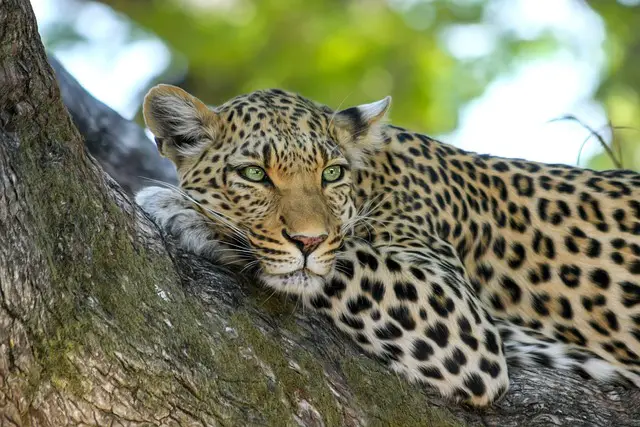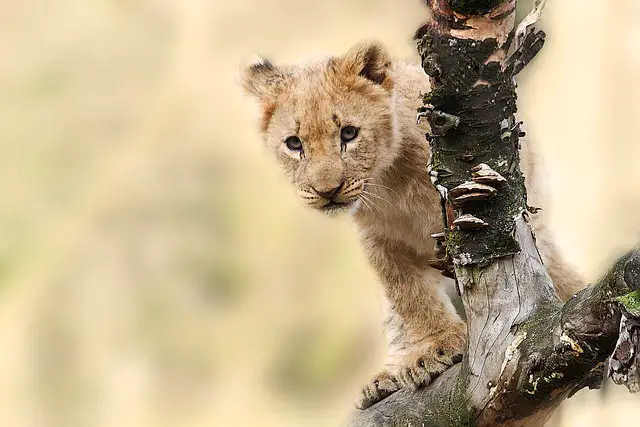Wild cats, such as lions, tigers, leopards, and jaguars, are among the most fascinating creatures on Earth.
These majestic animals are known for their strength, agility, and beauty. But how smart are they? This is a question that has intrigued scientists and animal lovers alike for years.
While it is difficult to measure intelligence in animals, researchers have conducted studies to determine the cognitive abilities of wild cats.
Some studies suggest that wild cats are highly intelligent and have impressive problem-solving skills.
For example, researchers have observed lions working together to hunt prey, using coordinated tactics to increase their chances of success.
Similarly, tigers have been observed using tools, such as sticks, to reach food that is out of reach.
However, other studies have found that wild cats may not be as intelligent as previously thought.
For example, some researchers have found that wild cats have difficulty recognizing themselves in mirrors, which is considered a sign of self-awareness and intelligence in some animals.
Additionally, wild cats have been observed engaging in repetitive behaviors, such as pacing, which is often associated with boredom and lack of stimulation.
Overall, the question of whether wild cats are smart is a complex one, with no simple answer.
Understanding Wild Cats’ Intelligence
Wild cats are known for their intelligence, which they use to survive in their natural habitats.
They have evolved to become highly skilled hunters and are able to adapt to various environments. Here are some key factors that contribute to their intelligence:
Problem-Solving Skills
Wild cats are excellent problem solvers. They use their intelligence to figure out how to catch their prey, navigate through their environment, and avoid danger.
For example, cheetahs are able to calculate the speed and trajectory of their prey, while lions use teamwork to take down larger prey.
Social Intelligence
Many wild cats are social animals, which means that they have to be able to communicate and interact with other members of their species.
They use a variety of vocalizations and body language to convey information and establish dominance. For example, tigers use vocalizations to communicate with other tigers in their territory, while leopards use scent marking to establish their territory.
Learning and Memory
Wild cats have excellent learning and memory skills. They are able to remember where they have found food and water sources, as well as where they have encountered danger.
They are also able to learn from their mistakes and adjust their behavior accordingly.
For example, jaguars have been observed using trial and error to figure out how to catch caiman, while snow leopards are able to remember the location of prey they have killed for future meals.
Overall, wild cats are highly intelligent animals that have evolved to survive in their natural habitats.
Their problem-solving skills, social intelligence, and learning and memory abilities all contribute to their intelligence and make them fascinating animals to study.
Cognitive Abilities of Wild Cats
Wild cats are known for their exceptional hunting abilities, which require a high level of cognitive functioning. These feline predators have developed a range of skills and strategies to survive in their natural habitats.
One of the most impressive cognitive abilities of wild cats is their spatial memory. They are able to navigate complex environments and remember the location of prey, water sources, and other important resources.
This skill is particularly important for cats that live in large territories, such as lions and tigers.
Wild cats are also skilled problem solvers. They are able to use their intelligence to overcome obstacles and find new ways to hunt and survive.
For example, some cats have been observed using tools, such as sticks or rocks, to catch prey or access hard-to-reach resources.
In addition to their problem-solving abilities, wild cats are also highly adaptable. They are able to learn from their experiences and adjust their behavior accordingly.
This allows them to thrive in a variety of environments, from deserts to rainforests.
Overall, the cognitive abilities of wild cats are truly remarkable.
These intelligent predators have developed a range of skills and strategies to survive in their natural habitats, making them one of the most successful groups of animals on the planet.
Problem-Solving Skills
Wild cats are known for their exceptional problem-solving skills. They have evolved to be excellent hunters, and this has led to the development of their impressive cognitive abilities.
They are capable of adapting to new situations and coming up with innovative solutions to problems.
One of the ways in which wild cats display their problem-solving skills is through their hunting techniques.
For example, cheetahs have been observed using trees as vantage points to survey their prey before launching an attack. This shows that they are capable of planning and strategizing before making a move.
In addition, wild cats have been known to use tools to aid in their hunting. For example, some species of wild cats have been observed using sticks to extract insects from tree bark.
This demonstrates their ability to innovate and use resources in their environment to solve problems.
Overall, wild cats have impressive problem-solving skills that have allowed them to survive and thrive in their natural habitats.
Their ability to adapt to new situations and come up with innovative solutions to problems is a testament to their intelligence and cognitive abilities.
Wild Cats and Their Adaptability
Wild cats are known for their incredible adaptability, which has allowed them to survive in a variety of environments and conditions.
They are intelligent creatures that have developed a range of behaviors and skills to help them thrive in the wild.
One of the key factors in the adaptability of wild cats is their ability to hunt and feed on a wide range of prey.
They are opportunistic hunters, which means that they will take advantage of any available food source, whether it’s a small rodent or a large herbivore.
This flexibility in their diet allows them to survive in different environments, from the dense forests to the open savannas.
Wild cats are also skilled climbers and swimmers, which gives them an advantage in different habitats. They can climb trees to escape predators or to hunt prey, and they can swim across rivers and lakes to reach new territories or to hunt aquatic animals.
Another important aspect of the adaptability of wild cats is their social behavior. Some species, like lions, live in large prides that work together to hunt and defend their territory.
Other species, like leopards, are solitary hunters that use their stealth and agility to catch prey. This flexibility in social behavior allows wild cats to thrive in different environments and conditions.
Overall, the adaptability of wild cats is a testament to their intelligence and resilience.
They have developed a range of behaviors and skills that allow them to survive and thrive in the wild, making them one of the most successful predators on the planet.
Social Intelligence in Wild Cats
Wild cats are known for their solitary behavior, but they also exhibit social intelligence in certain situations. For example, lions live in prides and have a complex social structure that involves cooperation and communication. They work together to hunt prey, protect their territory, and raise their young.
Similarly, cheetahs have been observed forming coalitions with other cheetahs to increase their chances of hunting success. These coalitions are often formed between siblings or unrelated individuals, and they communicate with each other through vocalizations and body language.
Another example of social intelligence in wild cats is seen in domestic cats. While they may not live in large social groups like lions, they have been observed communicating with each other through body language, vocalizations, and even scent marking.
They also exhibit social learning, where they observe and learn from other cats in their environment.
Overall, while wild cats may be known for their solitary behavior, they do exhibit social intelligence in certain situations. Their ability to communicate and cooperate with each other shows that they are not only intelligent but also adaptable animals.
Wild Cats vs Domestic Cats: A Comparative Study
Wild cats and domestic cats are both members of the Felidae family, but they have some key differences that set them apart. One of the most significant differences is their level of intelligence.
Wild cats, such as lions and tigers, are known for their intelligence and problem-solving abilities. They have to be smart to survive in the wild, where they face a variety of challenges, including finding food and avoiding predators.
In fact, some studies have shown that wild cats are even smarter than some primates when it comes to certain tasks.
Domestic cats, on the other hand, are often seen as being aloof and not very intelligent. However, this is a misconception. While they may not have the same level of problem-solving abilities as their wild counterparts, domestic cats are still quite intelligent.
They are able to learn and remember routines, and they can even be trained to do tricks.
One reason why domestic cats may be perceived as less intelligent than wild cats is that they have been bred for their looks rather than their abilities.
Domestic cats have been selectively bred for certain traits, such as long hair or a particular coat pattern, which has led to some unintended consequences, such as health problems and a decrease in intelligence.
In conclusion, while wild cats are generally considered to be smarter than domestic cats, both types of cats are intelligent in their own way.
Wild cats have evolved to be smart in order to survive in the wild, while domestic cats have adapted to living with humans and have learned to navigate their environment in their own unique way.
The Influence of Environment on Wild Cats’ Intelligence
Wild cats are known for their intelligence and adaptability, but their environment plays a crucial role in shaping their cognitive abilities.
Research has shown that wild cats living in challenging environments tend to exhibit higher levels of problem-solving skills and cognitive flexibility.
For example, a study conducted on African lions found that lions living in the Serengeti, where prey is scarce and unpredictable, are better at solving problems than lions living in areas with abundant prey.
Similarly, cheetahs living in the Kalahari Desert, where they face daily challenges such as finding water and avoiding predators, have been found to have superior cognitive abilities compared to those living in areas with fewer obstacles.
Moreover, wild cats that are forced to adapt to new environments, such as those living in zoos or rehabilitation centers, have been observed to exhibit higher levels of intelligence than their wild counterparts.
This is because they are constantly exposed to new stimuli and challenges that require them to use their cognitive abilities to adapt and survive.
In conclusion, the environment plays a crucial role in shaping the intelligence of wild cats. Those living in challenging environments or forced to adapt to new ones tend to exhibit higher levels of cognitive abilities and problem-solving skills.
Are Wild Cats Smarter Than We Think?
Wild cats have long been known for their impressive hunting skills and their ability to navigate through their natural habitats with ease. However, recent research suggests that their intelligence may go beyond what we previously thought.
One study conducted on African lions found that they are able to solve complex problems and exhibit social intelligence similar to that of primates. Another study on domestic cats found that they have the ability to understand human cues and manipulate their owners to get what they want.
Wild cats are also known for their adaptability. They are able to survive in a variety of environments and adjust their hunting strategies accordingly. For example, cheetahs are known for their speed, while leopards are skilled climbers and hunters of prey in trees.
Overall, while more research is needed, it appears that wild cats may be smarter than we previously thought. Their ability to problem-solve, exhibit social intelligence, and adapt to their surroundings suggests that they may be more than just skilled hunters.
Conclusion
In conclusion, wild cats are intelligent animals that exhibit a range of cognitive abilities. While they may not possess the same level of problem-solving skills as domesticated cats, they are highly adaptable and able to survive in a variety of environments.
Studies have shown that wild cats are capable of complex social interactions, including communication through vocalizations and body language. They are also skilled hunters, using their keen senses and physical abilities to catch prey.
However, it is important to note that each species of wild cat has its own unique characteristics and behaviors. Some, like the African wildcat, are more solitary, while others, like the lion, live in large prides.
Overall, while there is still much to learn about the intelligence and behavior of wild cats, it is clear that they are highly adaptable and capable animals that play an important role in their ecosystems.
[su_box title=”Affiliate Disclosure”]This website is supported by its readers. Please assume that all links are affiliate links. If you make a purchase from one of the links we will make a commission from Amazon. Thank you.[/su_box]




